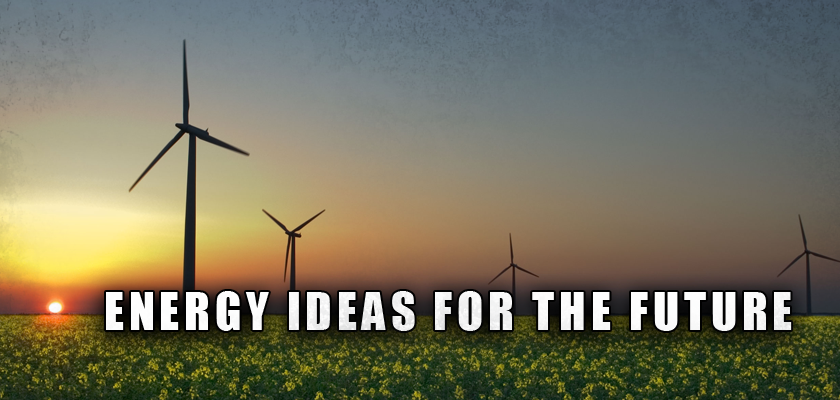Exploring Energy Ideas
Energy Ideas: a considerable debate lately has been about what to do about our energy prices. Another debate is on how we become self-sufficient and stop relying on our enemies to supply us with the fuel necessary to power our advanced civilization.
The funny part of this situation is how straightforward the answers to these questions are. Short of coming up with some new revolutionary means of energy (which I suppose is always an option), we have to rely on what we know and what we can feasibly do. This boils down to about three different options, with the final “option” probably not being an option so much as a smart-aleck suggestion.
Sometimes I can’t believe how backward some people can be. The intentions are great, but the ideas and the locations are horrible. An example of this is the “Wind Farms” in California. California isn’t exactly known for wind so much as the sun. It’s silly.
So option one is using accessible (or renewable) energy sources like the sun, the wind, the water, and any other means we can find.
California, Arizona, New Mexico, and Texas would be great locations for solar power plants. All industrialized nations share a need for electricity, and it is believed that solar power will increasingly be used as an option for electricity supply. This technology has not been efficient in the past; however, recent breakthroughs have made this a possible option for everyone, including the larger energy companies. Private investors have taken notice of this choice and believe that with more research and a little more focus on this energy, it can grow into the next big industry. Time will tell, and money will help.
The great plains are an excellent source of wind. This, in turn, makes it a fantastic area for wind farms. A wind farm is simply a collection of wind turbines pushed by the wind and converted into energy. It is kind of like an enormous alternator. An important restrictive factor of wind power is the inconsistent power generated by wind farms. In most locations, the wind blows only part of the time, so there has to be a backup facility of predictable power to cover periods when the wind is not blowing. However, with farms beginning to show up around the world, this form of energy creation holds weight, considering the success of other countries implementing the technology.
Water, or “hydropower,” holds incredible energy potential. Plants like the Hoover Damn, which generates an enormous about of energy, are great examples. Water has been used since the beginning of civilization to create certain types of energy, be it moving a simple rod or powering magnificent pieces of machinery that mill the people’s grain. Some people view hydropower as the ideal fuel for electricity generation because, unlike the nonrenewable fuels used to generate electricity, it is almost free, there are no waste products, and hydropower does not pollute the water or the air. Today there are many different types of hydro plants called hydroelectric power stations. These plants provide around 20% of the world’s electricity. As far as locations go, almost any moving body of water would be a decent place to start.
And regardless of where our next primary liquid fuel source or “gas” comes from, all three of the above are plentiful and cheap forms of electricity and should be implemented. But that does bring us to the next major issue; gas and liquid fuels.
Since “biofuels” such as ethanol are proving to be less than an acceptable fuel, I will not comment on this because the verdict is still out, and it would be better to speak about things we know. Today, oil is our primary energy source, and it is the world’s most important energy source. It is a vast industry where the consumption is around 84 million barrels per day or 3.6 trillion liters per year. But burning this oil releases carbon dioxide into the atmosphere, producing the unwelcome air pollution effect. This effect, which some believe contributes to a growing global warming problem, is a significant factor in many recent political debates. This proves on several levels that this fuel doesn’t lead us into the future and may hurt us in the long run.
Additionally, many believe that this form of fuel is running out and running out fast. In 2005, the world saw a dramatic decrease in oil production and a dramatic increase in oil prices which may indicate that the oil reserves we currently draw from are beginning to run out.
Furthermore, most Americans consider the locations we derive this energy from as hostile territories or, in simpler terms, enemy states. Today, the top oil producers are Saudi Arabia, Russia, the United States, Iran, Mexico, China, Norway, Canada, Venezuela, United Arab Emirates, Kuwait, Nigeria, the United Kingdom, and Iraq.
The United States consumes almost three times more fuel than China. We consume about 20 million barrels daily, nearly all of the oil we produce internally. We import almost 13 million barrels a day.
This presents a problem considering that our ties with Saudi Arabia, Russia, Iran, Venezuela, the UAE, Nigeria, Iraq, and Mexico are somewhat strained. We can not rely on another nation to supply us with energy if we plan on living a long prosperous life as a nation. We have to become self-sufficient.
So what is a good source of abundant fuel that doesn’t cause the problems that substances such as carbon-based fuels create? The answer might lie in a relatively new energy source called Hydrogen Fuel.
Hydrogen is consumed by a pollution-free chemical reaction–not combustion–in a fuel cell. The fuel cell combines hydrogen and oxygen chemically to create electricity, water, and waste heat. That’s it. It is also the most abundant chemical element, constituting approximately 75% of everything we know. Some scientists believe this number might be as high as 93%.
Hydrogen can be obtained from water by electrolysis or by splitting water molecules using electricity. But we’ve already covered where we can get a free form of electricity, so this isn’t even an issue.
An even more exciting prospect of this fuel type is how much you can get out of a simple glass of water. Denny Klein, who has already filed for a patent on his discovery and method for using this form of fuel, has converted his 1994 Ford Escort to run either as a water-gas hybrid or on water alone. His prototype could drive for 100 miles on only four ounces of water. Technically, the car isn’t running on water because the H20 is converted to HHO gas. This is said to provide the “atomic power of hydrogen” while maintaining the “chemical stability of water.” His company (Hydrogen Technology Applications, Inc) is currently developing a Hummer for the U.S. military that can run on water and gasoline. So far, according to insiders, his water-powered engines have passed all performance safety inspections and are undergoing testing from the U.S. Environmental Protection Agency and other private motorsports companies.
Similarly, Honda and other companies are already working on their versions of hydrogen-fueled cars. The technology is there and is getting close. We need to embrace these technologies, but we should also be willing to tap into our extra resources here at home. The fact is that these technologies are not in full swing yet. No matter how much we hate it, oil is still the most vital fuel we use here in the States. And until that situation changes, we need to recognize the need for oil and the steps necessary to keep oil in the fuel stash for a while. On the other hand, however, we also need to be willing to embrace new technologies when they present themselves to wean ourselves from the oil nipple.
Now the only problem I see with any of the preceding is that as we develop these abundant sources of energy, companies will lose an enormous amount of money. These companies have extensive ties with government officials. Furthermore, with abundant energy sources such as this, the dependency on such companies will fall dramatically. Many believe this will be the primary reason such energies will not be developed to the potential they probably could otherwise. This brings us to the final and smart-aleck suggestion.
We could suddenly resubscribe to manifest destiny and take over some of these nations that are currently supplying us with the oil we need. But that would, in turn, mean more war and oil, and frankly, it is just an absurd idea because we would still be faced with an ever-decreasing supply.
The way I see it, if the major oil companies would help develop these new energies, they could make a tremendous amount of money on the materials needed to construct, convert, and maintain the equipment that would drive these new technologies. All they would have to do is restructure their companies to be more diverse and beneficial rather than rely on a single source that is destructive and rapidly disappearing. As far as government intervention goes, a simple term limit would eradicate most of the bureaucracy involved.
You might also enjoy my article titled Corruption EVERYWHERE




